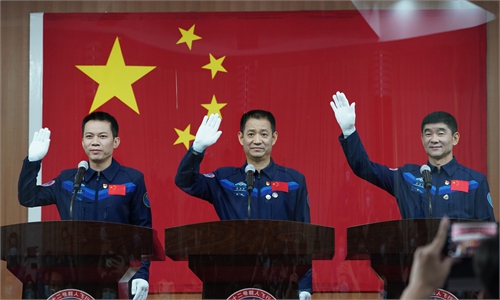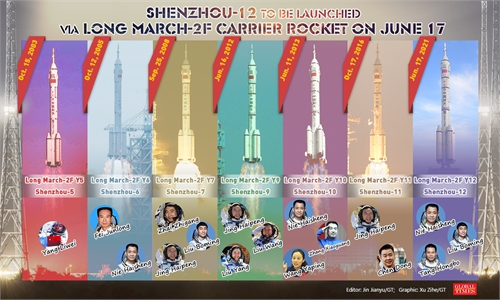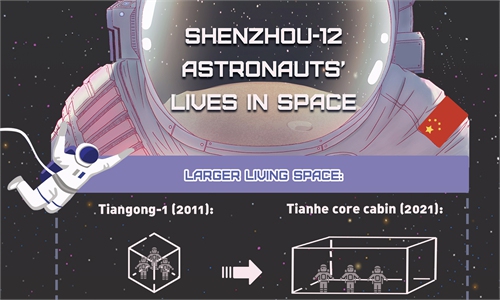China set to send three astronauts into space ahead of CPC centenary celebration
Crew to perform space walks, cozy 3-month stay
A historic review of China's manned space mission Video: GT
Space, here we come!China is set to launch the Shenzhou-12 manned spacecraft to ferry three astronauts, including two veteran astronauts, to its Tianhe space station core module at 9:22 am on Thursday, Global Times learned from the China Manned Space Agency (CMSA) on Wednesday.
According to the agency, astronauts to ride Shenzhou-12--Divine Vessel in Chinese - are Nie Haisheng, Liu Boming and Tang Hongbo, and the three made their public appearance prior to the launch at Wentian Pavilion in the Jiuquan Satellite Space Center, located in the Gobi Desert in Southwest China's Gansu Province on Wednesday during a press event.
Nie, 57, will board Shenzhou-12 for his third space flight and lead the mission, following his first during the Shenzhou-6 mission in October 2005 and second on Shenzhou-10 in June 2013. He was granted the title of "hero astronaut" after his second space mission, according to CMSA.
Liu, 55, will join Nie after his first trip to space in September 2008 during the Shenzhou-7 mission, for which he also received the honorary title of "hero astronaut."
The third crew member, Tang, 46, was selected from the second batch of astronauts in 2010.
The Divine Vessel will conduct rendezvous and docking in a fast automated mode on the front port of the Tianhe core module, to form a linear complex together with the Tianhe core module and Tianzhou-2 cargo spaceship.
The crew will conduct for the first time a long duration operation outside the cabin, with the support of robotic arms, Ji Qiming, CMSA spokesperson, said on Wednesday.
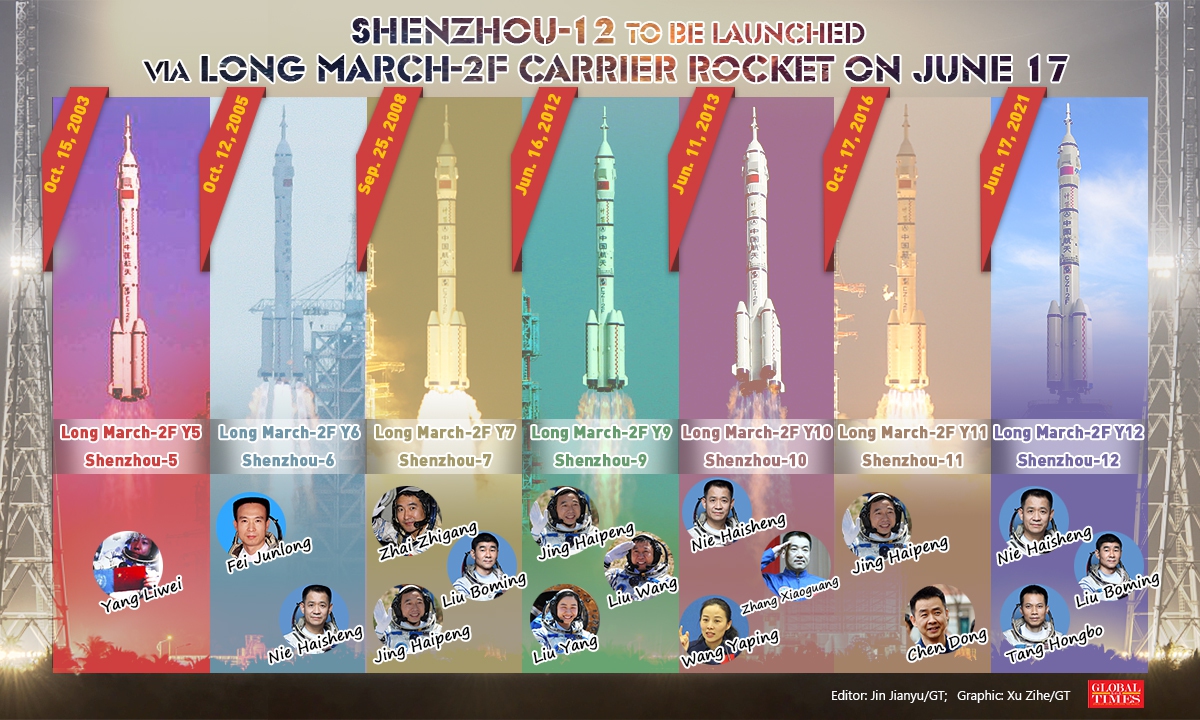
Shenzhou-12 to be launched via Long March-2F carrier rocket on June 17 Infographic:Xu Zihe/GT
The average age of the crew is 53, and some questioned why younger crew members were not chosen.
Wang Ya'nan, the editor-in-chief with the Aerospace Knowledge magazine, told the Global Times on Wednesday that the line-up was determined by the highly demanding mission content which includes a huge amount of work in and out of the cabin.
To accomplish an extended stay of 90 days in space, while conducting actual construction and maintenance work outside the cabin which could get risky, rather than just performing a spacewalk to verify such technology, it would be the safest option to deploy veterans, Wang said.
Analysts also noted that since Nie had participated in the space station technology verification mission of Shenzhou-10, and Liu had spacewalking experience during Shenzhou-7, it would be a perfect crew for them to take a relatively new face like Tang along, who has also trained for years and was one of the second batch of Chinese astronauts.
Liu, who had participated in the country's first spacewalk together with Zhai Zhigang during the Shenzhou-7 mission, is expected to play a crucial guiding role during outside cabin operations in the new mission, insiders told the Global Times.
After a stay of three months, the three will return on board the re-entry capsule to the Dongfeng landing site, the agency revealed on Wednesday, which is another first in the country's manned space mission history, as the Siziwang Banner landing site used to be the go-to site to receive returning crew.
The Dongfeng landing site located in the desert of North China's Inner Mongolia Autonomous Region has received the return capsule of the trial version of new-generation manned spacecraft, after a flight of two days and 19 hours in May 2020, Global Times previously reported.
The Tianhe core module and the Tianzhou-2 cargo ship complex are ready, with all equipment functioning well, ready for the rendezvous and docking and astronauts' entry, the agency said on Wednesday.
Also on Wednesday, CMSA officials disclosed that the Shenzhou-12 mission's back-up crew, of whom Wang Yaping, a woman astronaut who flew during the Shenzhou-10 mission in 2013, was in the line-up.
Shenzhou-12 is the fourth mission in the key technology verification phase, and the first manned mission in the space station phase.
China selected its first batch of 14 astronauts in the mid-1990s. Since 2003, it has sent six astronauts into space, including Yang Liwei, the country's first astronaut, and Zhai Zhigang, who carried out China's first space walk in September 2008.
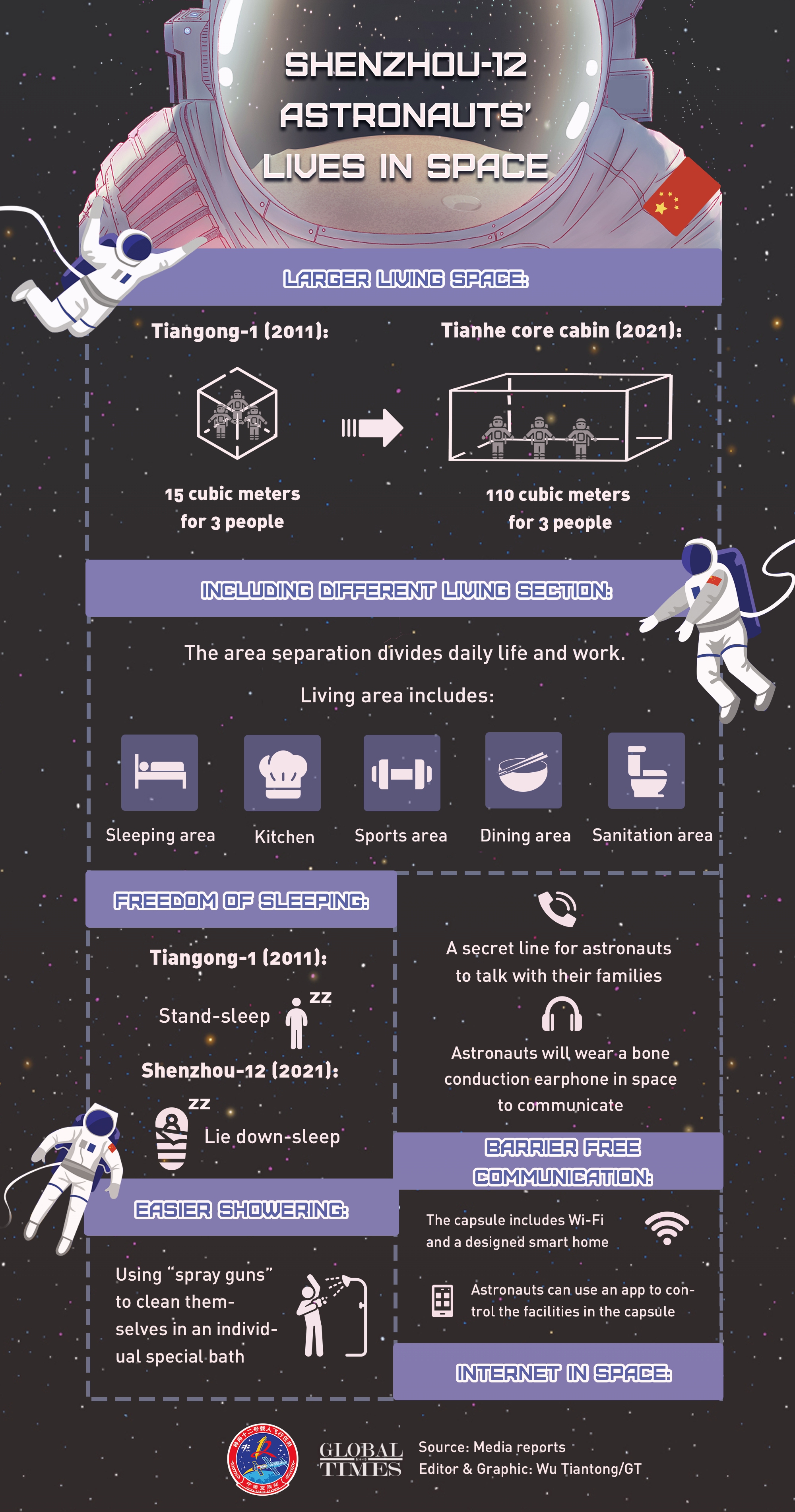
Shenzhou-12 astronauts' lives in space Infographic: Wu Tiantong/GT
A centenary tribute
As the first manned space station mission, the Shenzhou-12 flight is of utmost significance due to its crucial role in connecting the previous two missions and the following legs in the 11 intensive construction schedule, observers noted.
CMSA officials also said that the mission period coincides with the national celebration of Chinese Communist Party's centenary celebration, and all participants of the mission have drawn experience and strength from the Party history, especially from the development of the space industry under the leadership of the Party.
All three crew members are Party members, Global Times learned.
"I am an astronaut and have been a Party member for nearly 35 years. Since becoming an astronaut more than 20 years ago, I have personally witnessed the development of China's manned space, from one-person, one-day to multi-person, multi-day flights, from cabin work to space walks, and from short-term stay to mid-term stay," Nie told media on Wednesday.
"It can be said that the history of China's manned space program has condensed the nation's thousand-year dream of flying to the sky, while also adding a magnificent chapter to the Party's century-old struggle," the manned mission leader said.
The event soon triggered heated discussions on China's social media platforms, as the related topics of Shenzhou-12 drew some 300 million views on China's Twitter-like Sina Weibo as of press time.
Chinese netizens also said they would be thrilled and proud to see Chinese astronauts waving the Five-star Red Flag from space on July 1, the day of the 100th founding anniversary of the CPC.
Faster move, cozier stay
Gao Xu, the deputy director designer of the Shenzhou-12 with the project prime contractor China Academy of Space Technology (CAST), said the development of the manned spacecraft followed the highest standards in the country's space industry.
The nine meter-long, eight ton craft is made up of three sections: an orbiter module, a return module and a propelling module, and has 14 sub-systems on board. Gao referred to the spacecraft with a term of affection: "Vessel of life," as it will not only ferry three astronauts to the orbiting Tianhe core module, but will also carry them home to Earth in approximately 90 days.
According to CAST, Shenzhou-12 will attempt a fast and automatic rendezvous and docking with the Tianhe core cabin for manned spacecraft, a first in the country's history which can take place only 6.5 hours after launch, roughly time equivalent to a high-speed train trip from Beijing to Changsha, Central China's Hunan Province.
During the Tianzhou-2 cargo spacecraft's mission, China managed to pull off a fast but smooth automatic docking of the cargo ship with the Tianhe module within only eight hours after launch.
Pang Zhihao, a Beijing-based senior space expert, hailed the breakthrough technology, saying it would tremendously benefit manned missions, as it would save astronauts from longer stays in the narrow space on board the spacecraft, making their space travel more comfortable.
Apart from faster transport from Earth to space, the Tianhe core cabin has provided a much cozier environment for astronauts' long-term stay.
The room for in-cabin activities has expanded greatly compared to that in Tiangong 1 and 2, which is six times larger from 15 cubic meters to 110 cubic meters, with three separate bedrooms and one bathroom, the Global Times learned from developers of the space station program contractor China Aerospace Science and Technology Corporation (CASC).
A number of new technologies have been applied on the core cabin, including information technology that allows broader bandwidth between space and Earth, and one-on-one private connections, as well as smart home applications that can be controlled by phone apps, providing a cozier living environment for astronauts on board. Wireless communication is also equipped using Wi-Fi and Bluetooth technologies.
Over 120 kinds of space food are available on the station with balanced nutrition, a rich variety, and good taste, CMSA said, among which are the celebrated Chinese favorites - Kung Pao chicken and Yuxiang shredded pork.
Although hardware and software on board the station have been updated for astronauts to better adapt to the space environment, Pang told the Global Times on Wednesday it would still be a challenging task both for the astronauts' mental and physical status, as the duration of their stay will be much longer, and a great deal of the unknown is yet to be discovered and dealt with.
Open arms for intl joint flights
Ahead of the much-anticipated voyage of China's Shenzhou-12 mission, the general director of Russia's space agency, Roscosmos Dmitry Rogozin, expressed his willingness to work with Chinese counterparts in future cooperation in China's space station on Tuesday, saying that the possibility of Russian cosmonauts flying to the Chinese space station are being studied.
Roscosmos' declarations came after Russia threatened to leave the International Space Station in 2025 unless the US lifts sanctions against Russia, which has forbidden the country from importing certain microchips required for its space programs, space.com, a New York-based premier source for worldwide space news, reported in early June.
Russian media TASS asked at the press conference held by CMSA on Wednesday if China will invite other countries including Russia to participate in the scientific research on board China's space station, and whether foreign astronauts will be considered to fly with Chinese crew in future missions.
Ji said China and Russia have always maintained close ties in cooperating in space, and that the two sides are negotiating on widening the scope to more areas as more extensive exchanges are being made in the fields of a near-Earth orbit space station and manned deep-space explorations. And there will be more joint space laboratory projects between the two countries in the near future.
Meanwhile on Tuesday, NASA chief Bill Nelson said at a hearing of the US Senate Appropriations Committee that China will soon behave "very energetically" in space, since it "understands the value of success in space," and Washington should closely monitor the joint plans of Moscow and Beijing to explore the moon, TASS reported.
"I think you see the statements that the Chinese government is making that they do not want to wait until the 2030s to land a man on the moon… And I think that this will become a question for all of you… how valuable would it be for the United States to return to the moon first," he stressed.
Elaborating on space cooperation, Bo Linhou, vice chief designer of Tianhe core module, told the Global Times in April that it will mainly conduct payload experiments. "Scientists from China and other foreign partners could jointly develop a payload device that will be brought to the station by cargo spacecraft, and after experiments are completed in orbit, the data could be shared with the international community."
In the latest show of the determination and confidence of China-Russia cooperation in the field of lunar and deeper-space exploration, the China National Space Administration (CNSA) and its Russian counterpart jointly released the International Lunar Research Station Roadmap (V1.0) and Guide for Partnership (V1.0), stressing once again their openness to all interested countries, international organizations and partners to join the ILRS project, Global Times learned from the China National Space Agency (CNSA) on Wednesday.
He added that for foreign astronauts intending to board the space station, they can either take China's Shenzhou spaceships or launch their own and dock it with the station, but a docking mechanism in line with Chinese standards is required, which is different from the mechanism currently used by the ISS.
The document released by the CNSA and the ROSCOSMOS discussed the definition, scientific objectives, implementation approaches, cooperation domains and cooperation opportunity proposals of ILRS to all interested countries, international organizations and international partners in the phases of the planning, demonstration, design, development, implementation, operation and scientific research of the ILRS project, CNSA told the Global Times in a statement on Wednesday.
China and Russia welcome international partners to participate in all above phases and all-hierarchy levels of each phase, the agency added.

As the first manned space station mission, the Shenzhou-12 flight is of utmost significance due to its crucial role in connecting the previous 2 missions and the following legs in the 11 intensive construction schedule.

